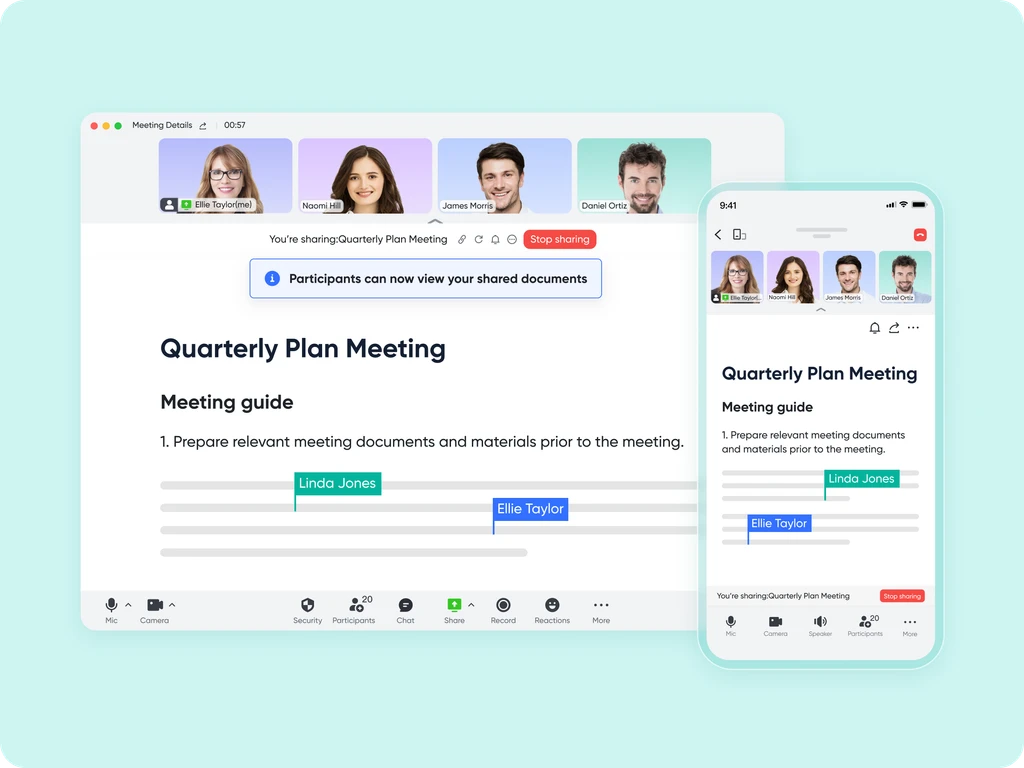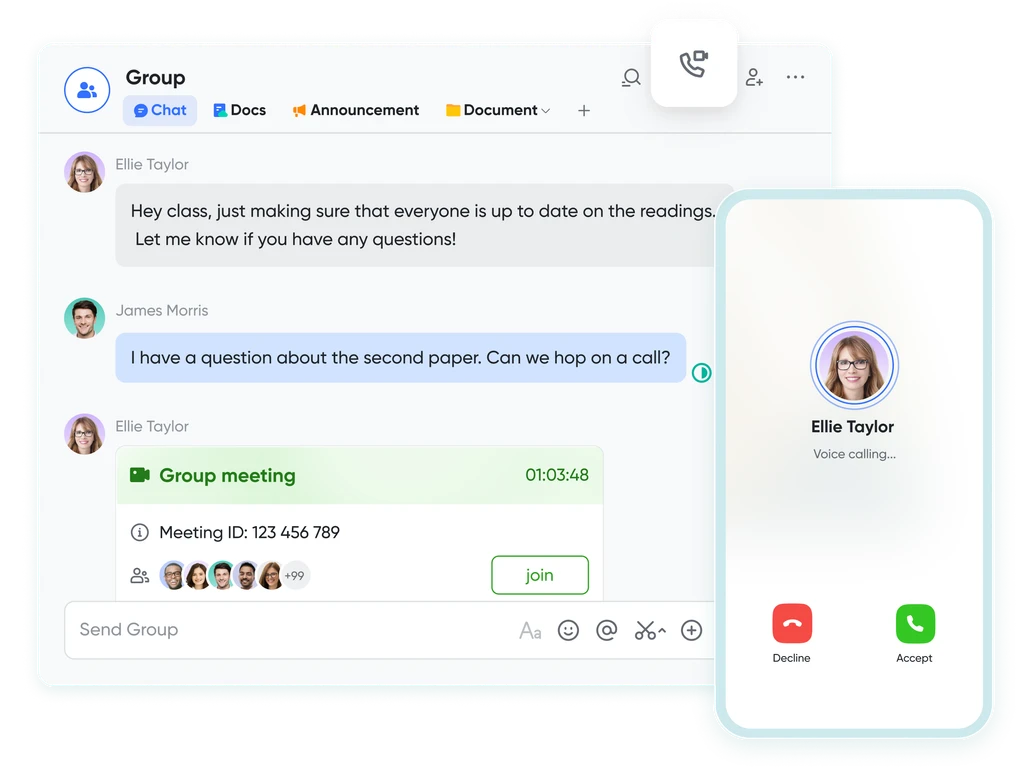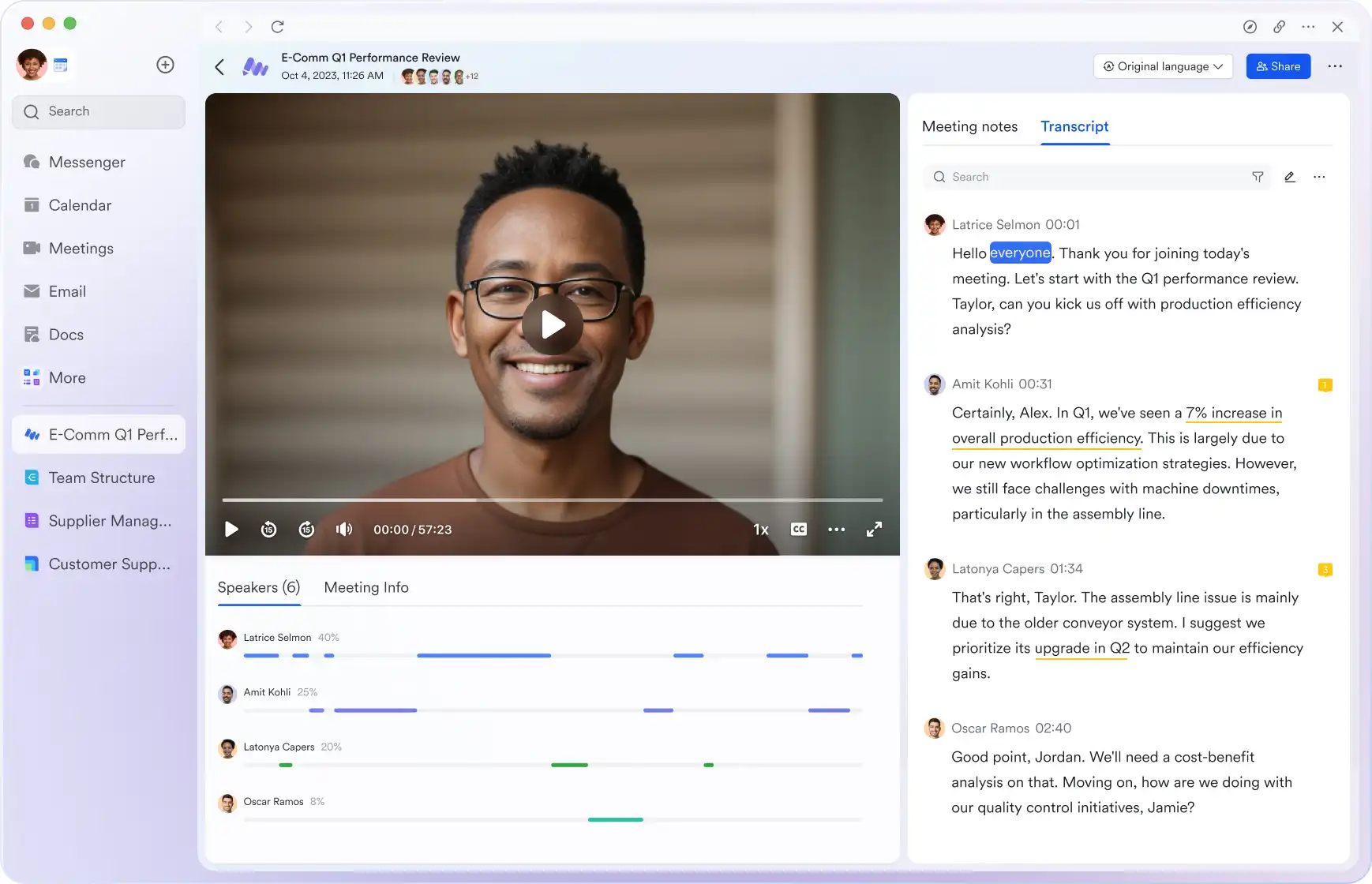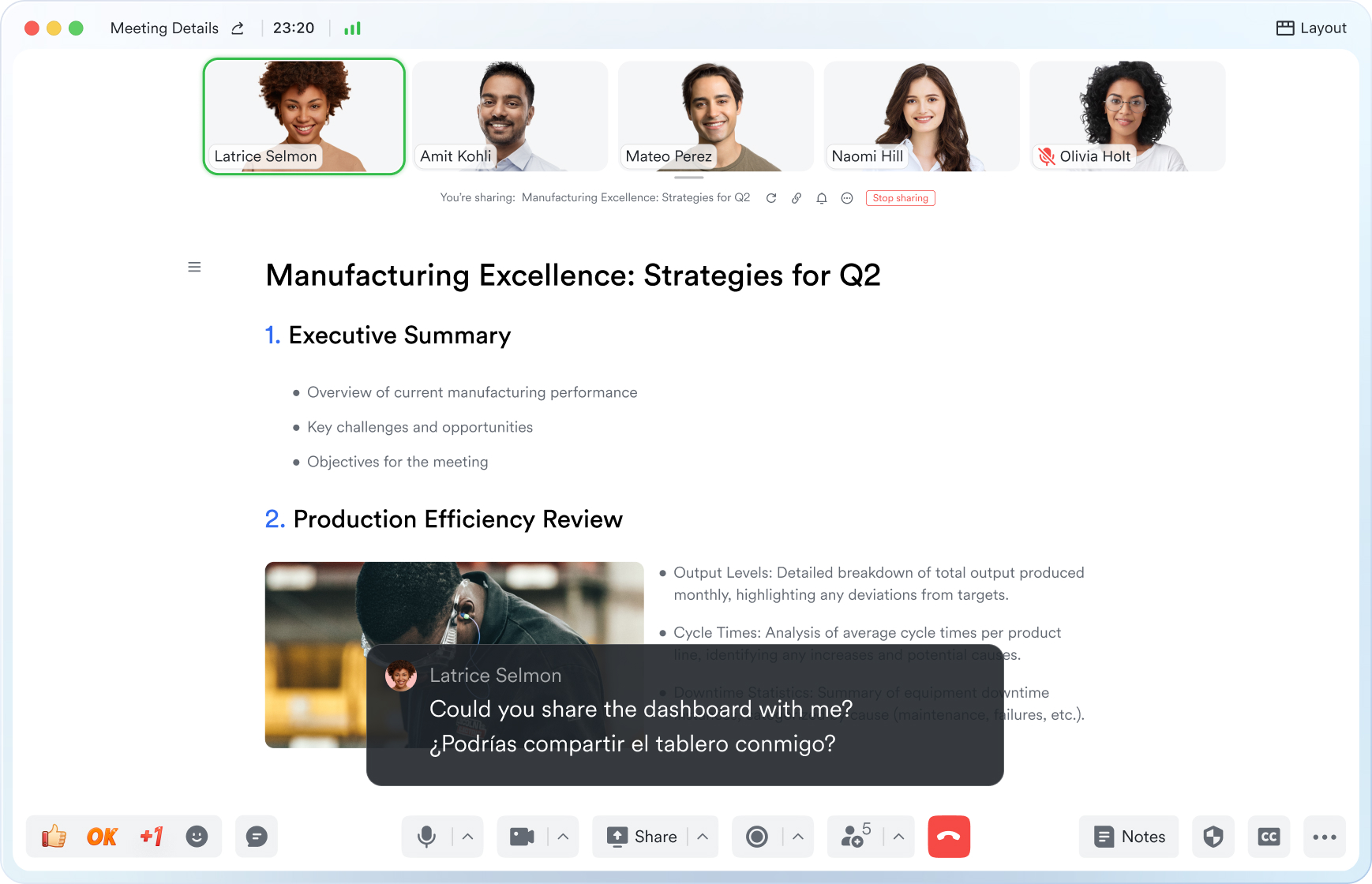One on One Meeting
This guide will walk you through the essential elements of use one on one meeting to keep your attendees aligned and engaged.
Try Lark for Free
1 on 1 meetings, also known as one-on-one meetings or 1:1 meetings, are a cornerstone of effective communication and collaboration in the workplace. These meetings offer a unique opportunity for managers, supervisors, or team leads to connect with individual team members on a personal level, address concerns, provide guidance, and foster professional growth. A well-structured 1 on 1 meeting can lead to increased productivity, enhanced job satisfaction, and stronger working relationships. In this comprehensive guide, we'll explore the significance of 1 on 1 meetings, how to conduct them effectively, and tips for maximizing their impact on individual and team performance.
Use Lark Meetings to turn meetings into true collaborative experiences.
What is a 1 on 1 meeting?
Understanding 1 on 1 Meetings
A 1 on 1 meeting is a private and focused conversation between a manager or supervisor and an individual team member. These meetings are typically recurring and serve as a dedicated time for discussing performance, goals, challenges, and career development. 1 on 1 meetings are a platform for open and honest communication.
Goals of a 1 on 1 meeting
Strengthening Relationships and Personal Development
The primary goals of a 1 on 1 meeting include:
- Relationship Building: Strengthening the professional relationship between the manager and the team member.
- Performance Review: Discussing current performance, accomplishments, and areas for improvement.
- Goal Alignment: Aligning individual goals with team and organizational objectives.
- Professional Development: Identifying opportunities for skill enhancement and career growth.
Who should attend a 1 on 1 meeting?
Key Participants
1 on 1 meetings involve the following key participants:
- Manager or Supervisor: The individual responsible for conducting the meeting.
- Team Member: The employee or team member participating in the meeting.
Learn more about Lark x Meetings
Topics, agenda, and structure of a 1 on 1 meeting
Structuring the Meeting
A well-structured 1 on 1 meeting typically includes the following components:
- Opening and Welcome: Setting a positive tone and creating a comfortable environment.
- Performance Review: Discussing recent accomplishments and areas that need attention.
- Goal Progress: Reviewing progress toward individual and team goals.
- Challenges and Concerns: Addressing any challenges, concerns, or obstacles faced by the team member.
- Development and Growth: Identifying opportunities for skill development and career advancement.
- Action Items: Defining actionable steps and commitments for both the manager and the team member.
- Feedback and Recognition: Providing constructive feedback and recognizing achievements.
- Personalized Coaching: Offering guidance and support tailored to the team member's needs.
- Goal Setting: Collaboratively setting new goals and objectives.
- Closing and Next Steps: Summarizing key takeaways and outlining follow-up actions.
How to conduct an effective 1 on 1 meeting?
Step-by-Step Guide
Conducting an effective 1 on 1 meeting requires adherence to best practices and a well-defined process. Follow these steps for a successful 1 on 1 meeting:
- Schedule Regularly: Set consistent meeting intervals, such as weekly, bi-weekly, or monthly.
- Prepare in Advance: Both the manager and the team member should prepare agenda items and discussion points in advance.
- Active Listening: Actively listen to the team member's thoughts, concerns, and aspirations.
- Goal-Oriented: Keep the conversation focused on performance, goals, and development.
- Two-Way Communication: Encourage the team member to share their perspective and feedback.
- Feedback Delivery: Provide feedback that is specific, constructive, and actionable.
- Coaching and Support: Offer guidance and support to help the team member succeed.
- Action Planning: Define clear action items and responsibilities, with deadlines if necessary.
- Document Meeting Notes: Keep records of discussion points, action items, and commitments.
- Follow-Up: Ensure that action items are tracked and discussed in subsequent meetings.
Learn more about Lark x Meetings
How often should you hold 1 on 1 meetings?
Meeting Frequency
The frequency of 1 on 1 meetings can vary based on the organization's culture and the needs of the team member. Common frequencies include:
- Weekly: Suitable for ongoing support and performance tracking.
- Bi-Weekly: Ideal for balanced check-ins and development discussions.
- Monthly: Common for discussing longer-term goals and progress.
Key differences between 1 on 1 meetings and similar meetings
Understanding Distinctions
1 on 1 meetings have unique characteristics that distinguish them from other types of gatherings:
- Individual Focus: 1 on 1 meetings are exclusively between a manager and a team member.
- Personalized Development: They prioritize personalized coaching, feedback, and career development.
- Performance-Centric: The central focus is on individual performance and professional growth.
Learn more about Lark x Meetings
Common pitfalls of 1 on 1 meetings
Avoiding Mistakes
To ensure the success of 1 on 1 meetings, be cautious of these common pitfalls:
- Inconsistent Scheduling: Failing to schedule meetings regularly or sticking to the agenda.
- Lack of Preparation: Conducting meetings without proper preparation or agenda items.
- Monologue Meetings: Allowing the manager to dominate the conversation without seeking input.
- Neglecting Follow-Up: Not tracking progress on action items or addressing previous commitments.
Tips for maximizing the impact of 1 on 1 meetings
Enhancing Effectiveness
To make the most of 1 on 1 meetings, consider implementing these tips:
- Trust Building: Establish a trusting and open environment where team members feel comfortable sharing.
- Goal Alignment: Ensure that individual goals align with team and organizational objectives.
- Feedback Balance: Provide a balance of constructive feedback and positive reinforcement.
- Development Plan: Collaboratively create a development plan with actionable steps and milestones.
Related:
Master the Art of Meeting Notes with Lark for Enhanced Collaboration | Lark Blog | Lark BlogLearn more about Lark x Meetings
Examples
Real-world scenarios
Real-world scenarios
Let's explore three real-world scenarios of successful 1 on 1 meetings in various contexts:
Scenario 1: Weekly Project Update Meeting
Brief Content: A project manager conducts a weekly 1 on 1 meeting with a project team
member to review progress on a critical project. The meeting is held in a quiet conference room.
Detailed Content: The 1 on 1 meeting begins with a warm welcome and a brief catch-up on personal matters to build rapport. The project manager and team member review the project's current status, discussing achievements, challenges, and upcoming milestones. The team member expresses concerns about a potential delay in project timelines due to unforeseen issues. The manager provides guidance on how to address these challenges and offers additional resources and support. Together, they adjust the project plan and set new expectations. The meeting concludes with a renewed sense of confidence and alignment on project goals.
Scenario 2: Career Development 1 on 1 Meeting
Brief Content: A senior leader conducts a monthly 1 on 1 meeting with a high-potential employee as part of their career development plan. The meeting is conducted virtually.
Detailed Content: The 1 on 1 meeting begins with a discussion of the employee's long-term career goals and aspirations. The leader reviews the employee's progress in their current role and potential areas for advancement. They discuss the importance of acquiring specific skills and experiences to achieve the employee's career objectives. The leader provides recommendations for relevant training programs, mentorship opportunities, and potential stretch assignments. Together, they set goals for skill development and career advancement, including a timeline for progress reviews. The meeting ends with the employee feeling motivated and empowered to pursue their career goals.
Scenario 3: Performance Improvement 1 on 1 Meeting
Brief Content: A department manager conducts a 1 on 1 meeting with an employee who has been struggling with performance issues. The meeting is held in a private office.
Detailed Content: The 1 on 1 meeting begins with a supportive and empathetic tone as the manager acknowledges the employee's challenges. They review specific performance metrics and areas where improvement is needed. The employee shares personal concerns that may have been affecting their performance. The manager provides constructive feedback and offers assistance in addressing the issues, including additional training and coaching resources. They collaboratively develop a performance improvement plan with clear objectives and deadlines. The meeting concludes with the employee feeling heard and motivated to work on their performance.
Tips for do's and don'ts
Best Practices and Pitfalls to Avoid
Follow these do's and don'ts to ensure productive and effective 1 on 1 meetings:
| Do's | Don'ts |
|---|---|
| Build trust and establish a comfortable environment for open dialogue in 1 on 1 meetings. | Don't use 1 on 1 meetings as a platform for micromanagement or criticism. |
| Focus on the team member's individual development, career aspirations, and well-being. | Avoid canceling or rescheduling 1 on 1 meetings without a valid reason. |
| Encourage two-way communication and active participation from the team member. | Neglect to address the team member's concerns, questions, or feedback. |
| Collaboratively set clear goals, action items, and timelines for follow-up. | Disregard the importance of follow-up and accountability for action items and commitments. |
Use Lark Meetings to turn meetings into true collaborative experiences.
A Game Changer for One on One Meeting: Empower your team with Lark Meetings
In the fast-paced and dynamic world of modern business, effective communication and collaboration are crucial for success of One on One Meeting. Here we introduce Lark Meetings to serve as a centralized hub for all communication needs.
Transform your meetings into collaborative endeavors

Leverage the potency of in-call document sharing, intelligent meeting minutes, and mobile-optimized features to enhance productivity collaboratively, irrespective of your location or schedule.
Seamlessly collaborate in real-time, across any device

Share live documents instead of just screen views. Participants can navigate and edit simultaneously within the video call window, even while on the move.
Shift your focus to engagement, not note-taking

Lark Minutes automatically converts video meetings into transcripts, facilitating easy viewing, searching, and collaborative editing. Stay in the loop asynchronously, even if you can't attend the live meeting. Lark Minutes for meeting minutes support translation into 10+ different languages.
Break language barriers in communication

Lark Meetings provide real-time translation for subtitles, allowing individuals from diverse backgrounds to express themselves in their native languages. Ensure every voice is heard, regardless of geographical location. Live subtitles currently support translations from English, Chinese, and Japanese to 10+ different languages. See more translation feature in Lark.
Connect with larger audiences
Host dynamic online meetings and events accommodating up to 1,000 participants, with the flexibility of up to 50 breakout sessions for intimate group discussions within the larger meeting context. Try more Lark features for free.








